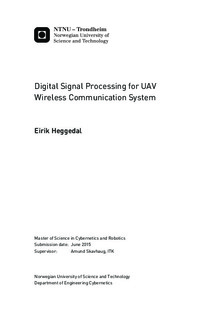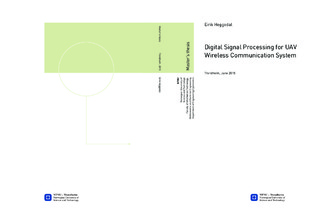| dc.description.abstract | This thesis was motivated by a student project with the goal of building a prototype for a vertical take-off and landing (VTOL) unmanned aerial vehicle (UAV). The goal was to determine what performance could be expected from the wireless communication system of this UAV by employing advanced digital signal processing techniques. This study was important to determine which applications this UAV is suitable for, and hence its commercial potential. A wast theoretic study was conducted to identify what factors prevents reliable communication with high data transfer rate. These factors was found to be limitations on signal bandwidth and emitted power, besides the high mobility of the UAV antenna. A fundamental challenge was identified: Increasing data transfer rate results in increased signal distortion. To facilitate a study on how to remedy this problem, an ergodic model of the communication system was derived, based on the filtered Gaussian noise method. Great effort was invested in finding a digital signal processing technique that could optimize for data transfer rate and reliability simultaneously. Various filtering techniques was studied. On-line identification of the communication channel was found to be a prerequisite for achieving an effective filter. The system identification problem was approached as a black box parameter estimation problem. Simulations revealed that the problem was non-convex. The problem was solved in a simulation with a channel model that exhibited perhaps unrealistically mild time-variant behaviour, using a global optimization method. However, the solution was not found within a satisfactory time period. It was therefore concluded that the non-convex problem is not suited to be solved on-line by an embedded computer within reasonable price range. Reliable communication must therefore be achieved by trading off data transfer rate. The three primary trade off mechanisms are the modulation order, the period between transmitted symbols, and data overhead containing error correcting code. Increasing the period between transmitted symbols is expected to yield the best results. Consequently, the expectation of limited data transfer rate is taken into consideration by the UAV development team. | |

